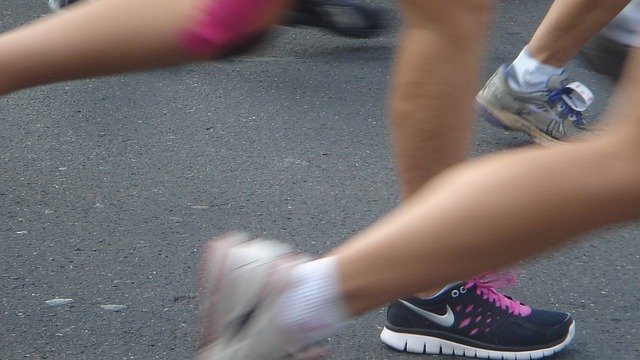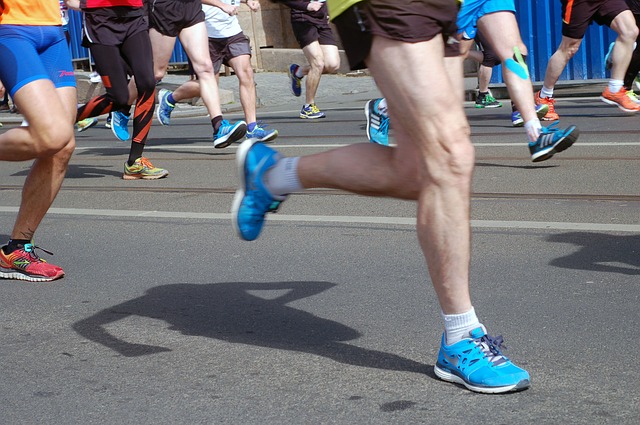Your foot is the first point of contact between the ground and your body. Since running is an impact sport, let’s be sure that foot strike is healthy!

Foot strike didn’t used to be so complicated.
During my running career, I had more than ten coaches at the high school and collegiate level. And none of them obsessed about heel strike, forefoot strike, or how the foot landed on the ground.
Of course, they encouraged us to have a healthy foot strike indirectly. Instead of actively coaching this aspect of running technique, we used a variety of training strategies that reinforced good form:
- Sprints and maximum-effort running
- Barefoot strides
- Form drills
- Trail running
This is actually a far better strategy instead of “over coaching” something that should happen by itself without serious interventions. Letting foot strike develop on its own ensures advancements are made only when you’re ready for them.
But that doesn’t mean we should completely ignore this valuable metric of running form.
If you’re hoping to score some new Personal Bests, foot strike can help your performances.
Or if you have a history of injuries, modifying your foot strike may reduce your risk of a future running injury.
First, we have to understand a few things:
- What exactly is foot strike and the different types that we can run with?
- Is there an optimum foot strike we ought to strive for?
- Do certain foot strikes have drawbacks?
- How can we make changes like this “second nature?”
You can also listen to a past episode of the Strength Running Podcast with running form expert Matt Phillips:
The topic of how your foot makes contact with the ground is big and broad. Let’s dive in.
What Foot Strikes Are Possible?
We only have a few varieties of foot strike available to us for running (unless you have something other than a human foot at the end of your leg).
The possible ways for your foot to strike the ground include:
- Heel first, commonly called heel striking
- Forefoot first, commonly called a forefoot strike
- A neutral landing, also known as a midfoot strike
It’s helpful to understand that these foot strikes exist on a continuum or spectrum. On one end, you have the heel strike. The midfoot strike is in the middle (it’s neutral, after all) and the forefoot strike is on the other side of this imaginary spectrum.
And even within this spectrum of foot strike, you can have variations:
- A proprioceptive heel strike is when the heel strikes first, but the full weight of the body comes down on the midfoot
- Mild forefoot strike (with minimal extra stress on the calf and soleus)
This continuum measures difficulty, mobility, or the skill level required for each type of foot strike.
In other words…
- A heel strike is easiest and requires the least amount of strength and skill (that’s why it’s more common among beginners)
- A neutral, midfoot strike requires more strength, athleticism, and skill
- A forefoot strike is the most difficult and requires the most strength and skill
Of course, our personal biomechanics play a big role in our running form. Some runners are far more able to run with a forefoot strike than others (and some struggle mightily). This is due to the structure of your body and how you’ve used it over the course of your lifetime.
But for most runners, they’ll see improvements in foot strike over time as they become more advanced.
As strength increases, experience and skill grow, and runners are introduced to a wider variety of workouts and training tools, their foot strike pattern will improve.
Does an Ideal Foot Strike Exist?

In a word, no. In fact, a large foot strike running study concluded that there’s no reason to worry too much about how your foot lands on the ground! The researchers note:
“These findings suggest there is no one optimal foot-strike pattern with regard to performance and athletes should not be overly encouraged to alter what comes naturally to them.”
I couldn’t have summarized the latest research better myself!
You can see this for yourself at any major race. Great runners have a variety of foot strikes – even at the elite level. Meb Keflezighi has a mild heel strike while Galen Rupp has a forefoot strike.
Both are world-class runners with a history of winning major races. But they have very different foot strike patterns.
Nevertheless, let’s discover what conditions affect our foot strike pattern:
- Speed (how quickly you’re running)
- Terrain (the surface you’re running on)
- Fatigue (how tired you are)
Each will have an effect on how your foot makes contact with the ground. What this means is that no runner should ever think that one type of foot strike is ideal. They’re all variations that have their place in your running.
Speed and Foot Strike
Speed is the most impactful factor that will change your foot strike. That’s because speed directly alters how our feet make initial contact with the ground.
The faster you run, the more likely you are to have a forefoot strike because it’s the most economical. You literally can’t sprint from your heels (though you can run very slow from your heels) so you have to “get up” on the ball of your foot to run hard.
Terrain and Foot Strike
Where you’re running will also change how your foot touches the ground. If you run uphill, it will be easier to have a forefoot strike. But downhill running makes more aggressive heel striking far more possible.
Gnarly terrain like technical trails will also cause you to run more on the balls of your feet. It’s this more athletic posture that allows you to navigate the roots, rocks, turns, holes, and other obstacles you’ll find on trails.
Fatigue and Foot Strike
Since a forefoot strike is more difficult, it will suffer when you’re tired. As fatigue mounts during a long run, race, or other challenging workout, your form will begin to deteriorate.
Anybody who’s seen video footage of their technique during the later stages of a marathon will know this feeling!
Related to this concept is that it may be beneficial to conserve energy by heel striking early in an ultramarathon when an aggressive forefoot strike may tire out your ankles. Since the ankle is controlled by smaller muscles than the knee or hip, it tires more easily.
More details on heel strike and other aspects of running form are here:
Like most complex topics, we can’t focus on one single metric when evaluating running form. Foot strike is important, but not more than posture or running cadence!
Aggressive Foot Strikes Demand Strength
Racing the Steeplechase in 2006 at Connecticut College
There are several aspects of running form that require a lot of strength. While you might hear that it’s optimal to have a forward lean or a forefoot strike, those are actually advanced aspects of running technique!
That’s because you have to be quite strong to execute them properly.
Without enough core strength to lean forward from the ankles, runners will instead lean from the waist. This puts too much pressure on the lower back, resulting in pain and potentially injury (so remember to get strong!).
And if you’re not strong enough for a forefoot strike, you might experience several problems:
- Achilles tendonitis
- A sore or twisted ankle
- Plantar fasciitis
- A strained soleus or calf muscle
Runners will remember a decade ago that after Born to Run was published, more people started adopting a midfoot or forefoot style of running. We were told that a heel strike running pattern would lead us to injury!
And podiatrists will gleefully remember that foot injuries exploded because shock was simply transferred from the hip and knee to the ankle.
Before we start making adjustments to how our foot lands – whether that’s forefoot, midfoot, or a heel strike – we have to get strong and do the training that makes it easier first.
Get started with foot strengthening exercises and progress to some (only a little!) barefoot running.
The Cues to Focus on Instead
We can worry about every small detail of our running form ad nauseam. But it won’t help us.
Instead of anxiously over-analyzing what should be done by our bodies subconsciously, let’s find a better way.
We can improve our technique with form cues – actionable coaching cues that make form changes far easier to implement.
Because foot strike isn’t something you should actively focus on improving, it’s not something that I encourage runners to think too much about.
We can get a more economical foot strike pattern with training:
- Trail running promotes a more varied, athletic posture and foot landing
- Speed development and sprints build strength and competence in the forefoot position
- Drills (especially those where you land in the forefoot position) reinforce proper form
- Barefoot running prevents many bad habits and reinforces sound technique
When you get fit, your foot strike will be a natural reflection of your coordination, athleticism, and strength.
If you’d like to work on your running form, download our Form Cues Guide.
I’ll show you three of my favorite cues for proper technique, how (and when) to execute them during a run, and the training strategies that make them easier to execute.
Best of all? They don’t take any extra time to use in your training.
Sign up here and I’ll send you the guide right away.